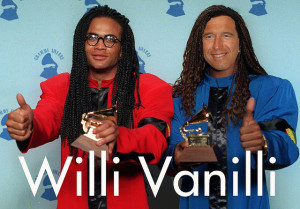
Brian Williams as Willi Vanilli
Chris Cillizza wrote a short Washington Post piece last Friday entitled “Who had the worst week in Washington? NBC’s Brian Williams.” Cillizza’s op-ed described how NBC Nightly News anchor Brian Williams was taken down by social media. In particular, Williams was placed on six months’ unpaid suspension, and may lose his job permanently, as a direct result of a Facebook comment by helicopter flight engineer Lance Reynolds, who disputed Williams’ oft-repeated story about being on a helicopter that was hit by enemy fire during the Iraq War. The social media takedown of Brian Williams was a keen observation by Cillizza, but social media are responsible for much than just Brian Williams’ job status. The Brian Williams debacle might be remembered as the moment where social media, and the Internet itself, overtook television.
For example, the three traditional TV networks, NBC, ABC and CBS, garnered about 26.8 million nightly newscast viewers during the week of January 12-16, 2015. “NBC Nightly News with Brian Williams,” the top rated TV network news program, draws about 9.6 million viewers per week. In comparison, as recently as 1980, the year that CNN launched nationwide cable TV news, the network evening news broadcasts garnered 55 million viewers each night. And that was when the U.S. population was about 90 million less than it is now. While many TV news viewers have shifted from the traditional networks to cable, viewership of cable TV is dropping too. Of the cable TV news channels, only Fox News breaks 1 million viewers per day during prime time, and its ratings are down as well.
Instead, Facebook is now a more popular source for political news than CNN or Fox, and Facebook has 1.39 billion users. Likewise, Twitter has 288 million users, with 63 percent using their smartphones as the primary method of access. The way Americans get their news and information has clearly changed.
Don’t forget the power of viral videos as well. For example, John Oliver‘s Net Neutrality segment on his new HBO program “Last Week Tonight” is credited with jump-starting the so far successful effort to convince the Federal Communications Commission to protect a free and open Internet. Oliver’s Net Neutrality segment has been viewed nearly 8 million times on Youtube. And just last Thursday, President Barack Obama, rather than making a stuffy speech for TV from the Oval Office, aired a funny Buzzfeed video designed to convince young Americans to sign up for healthcare coverage under the Affordable Care Act. Obama’s video has over 3.8 million Facebook likes and over 500,000 shares from its main website alone. Additionally, podcasts are a hugely popular alternative to TV, with programs like NPR‘s “Fresh Air” (including the hit “Invisibilia”) garnering 69 million downloads per month and Apple iTunes podcast subscriptions surpassing 1 billion in 2013.
There’s something else at work here too. In the case of social media and viral videos, each one of us isn’t just a receiver of information. We can be broadcasters as well, by posting and/or sharing items of interest to us. That’s what Lance Reynolds did when he wrote that fateful Facebook comment that took down Brian Williams, and which was viewed and shared many times. Moreover, a lot of social media users applied their Photoshop skills to come up with one of the most devastating mockery campaigns in recent history aimed at Williams, including the hilariously brutal Twitter hashtag #BrianWilliamsMisremembers. In each of these cases, if you set up your Facebook or Twitter network the right way, it can be the greatest news service ever invented, containing not just story headlines, but links to news stories anywhere in the world, brought to you within seconds of their occurrence. With such news and information at your fingertips, who needs Brian Williams and the nightly TV network news?
As these recent trends demonstrate, social media use has huge implications for our political process. However, it’s worth noting that, as with other media, social media are widely used for cat videos (the original Grumpy Cat has over 17.6 million views on YouTube), pornography and other less informative subjects, like “Evolution of Dance” with over 300 million views on YouTube. Just because social media is a revolution doesn’t mean it will make us smarter.
Image by H. Michael Karshis, used under Creative Commons license. http://is.gd/ghsrt2


